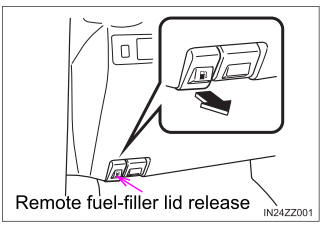Toyota Yaris: Winter Driving / Snow Tires
Use snow tires on all four wheels
Do not go faster than 75 mph (120 km/h) while driving with snow tires. Inflate snow tires 30 kPa (0.3 kgf/cm2, 4.3 psi) more than recommended on the tire pressure label (driver’s door frame), but never more than the maximum cold-tire pressure shown on the tires.
The vehicle is originally equipped with all season radials designed to be used all year around. In some extreme climates you may find it necessary to replace them with snow tires during the winter months to further improve traction on snow and ice covered roads.
WARNING
Use only the same size and type tires (snow, radial, or non-radial) on all four wheels
Using tires different in size or type is dangerous. Your vehicle’s handling could be greatly affected and result in an accident.
NOTICE
Check local regulations before using studded tires.
 Winter Driving
Winter Driving
Carry emergency gear, including tire chains, window scraper, flares, a
small shovel, jumper cables, and a small bag of sand or salt.
Ask your Toyota dealer to check the following:
Have the proper ratio of antifreeze in the radiator...
 Tire Chains
Tire Chains
Check local regulations before using tire chains.
Install the chains on the front tires only.
Do not use chains on the rear tires.
Please consult your Toyota dealer...
Other information:
Toyota Yaris XP210 (2020-2025) Reapir and Service Manual: Power Window Switch Malfunction (B2312)
DESCRIPTION The power window regulator motor assemblies are operated by the multiplex network master switch assembly or power window regulator switch assembly. The power window regulator motor assemblies have motor, regulator and ECU functions. This DTC is stored when the ECU built into a power window regulator motor assembly and multiplex network master switch assembly determine that the multiplex network master switch assembly or power window regulator switch assembly is stuck...
Toyota Yaris XP210 (2020-2025) Reapir and Service Manual: Parts Location
P..
Categories
- Manuals Home
- Toyota Yaris Owners Manual
- Toyota Yaris Service Manual
- Fuse Panel Description
- Fuel Gauge
- G16e-gts (engine Mechanical)
- New on site
- Most important about car
Refueling
Before refueling, close all the doors, windows, and the liftgate/trunk lid, and switch the ignition OFF.
To open the fuel-filler lid, pull the remote fuel-filler lid release.

